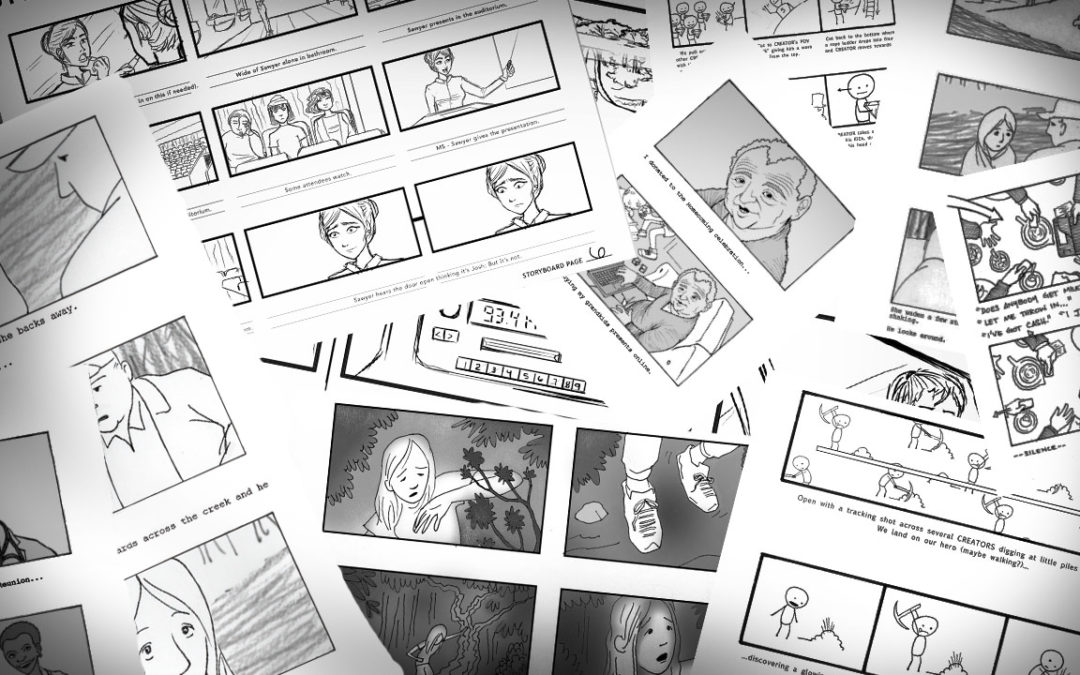Want to get the most out of your storyboard art? Check out these 5 Tips:
1. Communicate effectively with your artist
Storyboards are a great way to convey visual strategy, stylistic choices and comparisons to other films. But they’re useless if you’re having trouble communicating what you want. Make sure your storyboard artist knows what you expect from them by providing a detailed shot list. It’s also really helpful to have reference photos of your actors (if you’ve already cast) or scouting photos of a location you’ve locked down. And there’s nothing wrong with providing your artist with clips or stills from other films for reference. Also, since the artist can’t read your mind*, be sure to provide overheads of the scene. It will help them with screen direction and the 180º line. Finally, it’s important to have a conversation about how you both interpret different compositions. One person’s “medium shot” is another person’s “loose medium close-up,” so make sure to get on the same page.
* If they CAN read your mind, they’re in the wrong business!
2. Give the artist some creative agency
If you’re having trouble visualizing a scene or want another interpretation of the script, let your storyboard artist run with it. These artists are constantly working with shot size and composition, so their input is valuable. Remember, storyboard artists are also storytellers, and many of them may even have experience in other crew positions. Plus, if you give the artist creative license, their interpretation may give you cool ideas you never considered. The more you view your artist as a partner instead of just a tool, the more fruitful (and fun!) the collaboration will be.
3. Use storyboard art to get people excited
Using storyboard art in a pitch, lookbook, or crowdfunding campaign can help you raise money and get people excited even before the project gets off the ground. One cool thing a lot of filmmakers do is give away the original storyboard art, signed by the artist, to contributors. It’s a great incentive for donating to the Kickstarter or IndieGoGo campaign. You may also consider turning the art into an animatic with sound effects and music to give your investors a sense of how some challenging scenes will be put together. Animatics are particularly useful for visualizing scenes involving stunts or action. Who knows? When cutting together an animatic you might realize you don’t even need some of the shots you’d planned for, saving you time and money!
4. Respect the artist’s talent and time
Storyboard art is often an afterthought and is grossly under-budgeted. Less experienced filmmakers sometimes expect too much from their artists for way too little pay. It’s important to take care of them just like you would any other crew member. Treating the process as a necessary part of pre-production will really benefit your film, and give you a solid reputation as someone who takes filmmaking seriously. Even if you can only afford storyboard art for key elements or challenging scenes, it’s a worthwhile investment. And remember to budget for their time as well. As talented as they may be, artists aren’t magicians. Give them a reasonable amount of time to do the work you’re requesting and be patient with their process. Paying your artist for their talents and recognizing that art takes time will help you form a stronger relationship with them in the future.
5. Use art to speak visually to your crew
Storyboard art is useful well after production has begun. For example, maybe there’s one important color that needs to stand out in every frame, or perhaps you have a challenging scene where the color temperature changes from cool to warm. You can ask your artist to add color to help the DP and Production Designer visualize the look you had in mind and stay organized when shooting. And don’t forget to bring your boards to set! For those of us who are visual, crossing off storyboard frames instead of items on a shotlist can be really helpful. Most importantly, being able to immediately communicate shot size, motion, and composition is one of the best ways to stay organized and on track. And staying on track means saving time and money.

